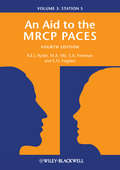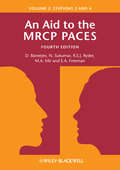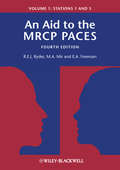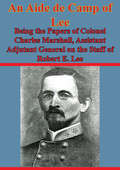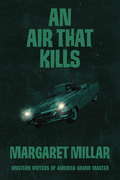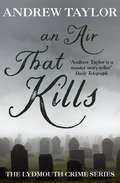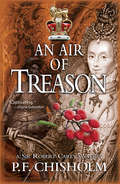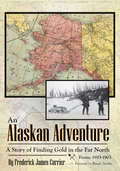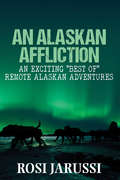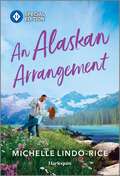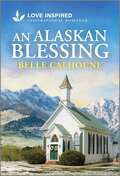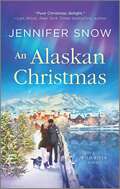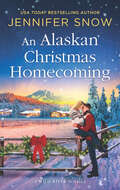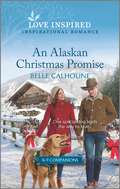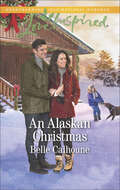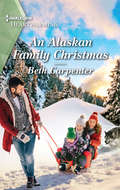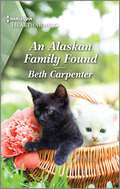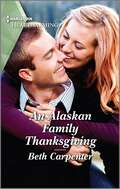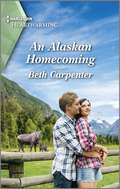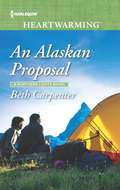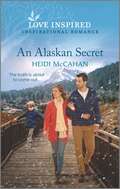- Table View
- List View
An Aid to the MRCP PACES
by Robert E. Ryder M. Afzal Mir Edward Fogden Anne FreemanAn Aid to the MRCP PACES Volume 3: Station 5 is a brand new, fully updated edition of the best-selling PACES revision guide to address the newest Station, covering Integrated Clinical Assessment, with content guided by the experiences of PACES candidates.The cases and scenarios have been written in accordance with the latest examining and marking schemes used for the exam providing an invaluable training and revision aid for all MRCP PACES candidates.In order to fully support candidates taking the exam, this trilogy of best-selling revision aids is now presented as:An Aid to the MRCP PACES Volume 1: Stations 1 and 3, Fourth Edition9780470655092An Aid to the MRCP PACES Volume 2: Stations 2 and 4, Fourth Edition9780470655184An Aid to the MRCP PACES Volume 3: Station 5, Fourth Edition9781118348055
An Aid to the MRCP PACES
by Robert E. Ryder E. Anne Freeman M. Afzal Mir N. Sukumar Dev BanerjeeThis new edition of An Aid to the MRCP Paces Volume 2: Stations 2 and 4 has been fully revised and updated, and reflects feedback from PACES candidates as to which cases frequently appear in each station.The cases and scenarios have been written in accordance with the latest examining and marking schemes used for the exam providing an invaluable training and revision aid for all MRCP PACES candidates.
An Aid to the MRCP PACES
by Robert E. Ryder E. Anne Freeman M. Afzal MirThis new edition of An Aid to the MRCP Paces Volume 1: Stations 1 and 3 has been fully revised and updated, and reflects feedback from PACES candidates as to which cases frequently appear in each station.The hundreds of cases have been written in accordance with the latest examining and marking schemes used for the exam and, together with exam hints, tips, routines and clinical checklists, provide an invaluable training and revision aid for all MRCP PACES candidates.
An Aide De Camp Of Lee - Being The Papers Of Colonel Charles Marshall,: Assistant Adjutant General On The Staff Of Robert E. Lee [Illustrated Edition]
by Colonel Charles Marshall Major-General Sir Frederick MauriceIncludes 19 Portraits and 6 maps."Charles Marshall was appointed aide-de-camp to Robert E. Lee on 21 March 1862, and from then until the surrender, he stood at the general's side. A military secretary, he compiled a remarkable, intimate account of the day-to-day wartime experience of the Confederacy's most celebrated--and enigmatic--military figure.Marshall's papers are of three sorts: those intended for a projected life of Lee, those intended for an account of the campaign at Gettysburg, and notes on events of the war. Collected here, these papers provide a unique firsthand look at Lee's generalship-from the most complete account ever given of the fateful orders issued to Jeb Stuart at Gettysburg, to the only testimony from a Southern witness of the scene in McLean's house at Appomattox.Marshall's commentary addresses some of the war's more intriguing questions: Whose idea was it to fight the second Manassas? What caused Jackson's delays in the Battles of the Seven Days? Who devised the flank march around Hooker at Chancellorsville? This book's insights into Robert E. Lee and his military strategy and its close-up report on the Confederacy's war qualify it as an indispensable part of America's historical record."-Print Ed.
An Air Fighter's Scrapbook (Vintage Aviation Library)
by Ira JonesA classic memoir of the early days of aviation by a longtime Royal Air Force pilot, including his harrowing, exhilarating adventures in the Great War. Ira &“Taffy&” Jones was a well-known air fighter during the First World War, having scored about forty victories flying SE5 scouts in France with 74 Squadron. Familiar in flying circles, Jones recorded stories drawn from his own experiences during the war and wrote of the many personalities he had met or known by association, both during the war and in the postwar flying years. An Air Fighter&’s Scrapbook recreates the atmosphere of the days of the biplane, of wartime flying, of early peacetime adventures in the air, the development of civil aviation, and breathtaking record-beating flights—all evoking the sheer delight in flying that characterized those early years.
An Air That Kills
by Margaret MillarA gripping novel of ordinary lives ripped apart by lust, deceit, adultery, conspiracy and betrayal On a Saturday night in April, Ron Galloway's friends have all arrived at his Ontario lakeside vacation lodge for a boys' weekend without their wives. But as the night wears on and the host himself doesn't arrive, the party turns sour. Then Ron Galloway's suspicious wife, convinced he is having an affair and trying to track him down, arrives on the scene, followed by the police. It is clear something is very wrong. In the hours and days that follow Ron Galloway's disappearance, the secret of an ugly infidelity comes to light, tearing apart Galloway's circle of friends and destroying two marriages. Did Ron Galloway commit suicide to escape his own unforgivable betrayals? What sinister set of circumstances brought him to his desperate end, and how will his survivors cope with the truth without tearing one another apart?
An Air That Kills: The Lydmouth Crime Series Book 1
by Andrew Taylor'Andrew Taylor is a master story-teller' Daily TelegraphFrom the No.1 bestselling author of The Ashes of London and Fire of Court, this is the first instalment in the acclaimed Lydmouth seriesWorkmen in the small market town of Lydmouth are demolishing an old cottage. A sledgehammer smashes into what looks like a solid wall. Instead, layers of wallpaper conceal the door of a locked cupboard which holds a box - and in the box is the skeleton of a young baby. Items within the box suggest that the baby was entombed early in the nineteenth century, but when another man is also found dead, the evidence suggests that the baby's death is more recent and that a killer is on the loose. For Journalist Jill Francis, newly arrived from London, this looks like her first story to chase ... 'The most under-rated crime writer in Britain today' Val McDermid'Captures perfectly the drab atmosphere and cloying morality of the 1950s . . . Taylor is an excellent writer. He plots with care and intelligence and the solution to the mystery is satisfyingly chilling' The Times 'There is no denying Taylor's talent, his prose exudes a quality uncommon among his contemporaries' Time Out 'Andrew Taylor is a master story-teller' Daily Telegraph
An Air That Kills: The Lydmouth Crime Series Book 1
by Andrew Taylor'Andrew Taylor is a master story-teller' Daily TelegraphFrom the No.1 bestselling author of The Ashes of London and Fire of Court, this is the first instalment in the acclaimed Lydmouth seriesWorkmen in the small market town of Lydmouth are demolishing an old cottage. A sledgehammer smashes into what looks like a solid wall. Instead, layers of wallpaper conceal the door of a locked cupboard which holds a box - and in the box is the skeleton of a young baby. Items within the box suggest that the baby was entombed early in the nineteenth century, but when another man is also found dead, the evidence suggests that the baby's death is more recent and that a killer is on the loose. For Journalist Jill Francis, newly arrived from London, this looks like her first story to chase ... 'The most under-rated crime writer in Britain today' Val McDermid'Captures perfectly the drab atmosphere and cloying morality of the 1950s . . . Taylor is an excellent writer. He plots with care and intelligence and the solution to the mystery is satisfyingly chilling'The Times 'There is no denying Taylor's talent, his prose exudes a quality uncommon among his contemporaries' Time Out 'Andrew Taylor is a master story-teller' Daily Telegraph
An Air of Glory
by Sarah NeilanIt is the year 1801. Polly Forster is a beautiful but penniless Northumbrian girl who longs to escape from a stifling, unhappy existence as a companion to a miserly spinster cousin. And now her chance has come. The romantic and mysterious man she has met at the home of a friend has charged her with a dangerous mission--to carry an urgent and unknown message to the last remaining Jacobites among the Scottish settlers in Nova Scotia. In a moment of mad passion she accepts the charge--and his offer of a rendezvous in Canada and a promise of marriage. Polly embarks on the Agnes MacVeagh, a sailing ship bound for Pictou, Nova Scotia, with a cargo of refugees from the Highland Clearances in Scotland. But on the hazardous voyage Polly is assailed by doubts. New friends have opened wider vistas for her, and unexpected incidents force her to question her reckless actions and her relationship with Lucian, a man whom she barely knows. Does he really love her? What will happen if he breaks his word? What is in the Jacobite letter? And how much does the British government agent on the ship, the handsome, fascinating yet enigmatic Augustus Fenwick, know about Polly's curious involvement in a treasonable enterprise that is punishable by hanging? Polly must discover the answers to these and many other questions before the perilous voyage is ended if she is to find the happiness she seeks in the new world.
An Air of Treason: A Sir Robert Carey Mystery (Sir Robert Carey Series #6)
by P F ChisholmAfter his hair-raising adventures in London, Sir Robert Carey has finally tracked down Queen Elizabeth, who orders him to investigate the most dangerous cold case of her reign - the mysterious 1560 death of Amy Dudley (née Robsart), unloved wife of Robert Dudley, Earl of Leicester. Some thirty years back, the late Dudley was Elizabeth's favorite suitor and potential husband. The Queen has since been one of the most obvious suspects in arranging Amy's murder. This makes Carey deeply uneasy with his sleuthing role. Then someone manages to poison Carey with belladonna, which temporarily blinds him. Worse still, the steadfast Sergeant Dodd has disappeared on the road from London. As the Queen's scandalous past collides with her magnificent State entrance into Oxford, can Carey rally in time to find both Dodd and the true murderer of Amy Robsart?
An Airplane for Pig (Fountas & Pinnell Classroom, Guided Reading)
by Maryann Dobeck Jackie UrbanovicNIMAC-sourced textbook
An Alaskan Adventure: A Story of Finding Gold in the Far North From: 1893-1903
by Frederick James CurrierAs the descendant of early miners, a grandfather who prospected for gold in the Fairbanks area in 1908 and a father who mined from the 1920s through the early 1940s, my interest and fascination with Frederick Currier's manuscript was easily spiked. Currier's quest for gold from 1893 into the 1900s was an admirable pursuit. His account of prospecting ventures in 1898 on the Chena River near Fairbanks is spellbinding, especially in his use of a sternwheeler and his building of cabins as he prospected toward the headwaters. I have great admiration for the early gold prospectors like Frederick Currier since I have sunk a couple of shafts to bedrock with a windlass and know the effort and determination required. The power of a few nuggets can change a person's direction in life. Currier's, An Alaskan Adventure, is well worth reading—more than once.
An Alaskan Affliction: An Exciting “Best Of” Remote Alaskan Adventures
by Rosi JarussiAn Alaskan Affliction is packed with pure entertainment, featuring highlights from decades of Alaska hard core adventures. It opens with unforgettable dog mushing to embrace the best of the Interior's extreme winters, and snowmachining that doubles the thrills and mishaps of travel over river ice, through blizzards, and sudden whiteouts. Summer offers the finest river journeys. There are sudden storms, log jams, whirlpools, and wildlife encounters in the immense panorama of wilderness and water—with a vivid portrait of the dynamics of being a team member in the bush. The remote prospecting stories are thrilling and risky, and demand a lifetime of bush skills. They end with a resounding bear story that catalyzes the true essence of living and exploring as an Alaskan. All are top notch adventures with good dogs and old machines, undersized kayaks and cantankerous boats, with a touch of lunacy and a can-do attitude, both essential dispositions for exploring Alaska's wilds.
An Alaskan Arrangement (Seven Brides for Seven Brothers)
by Michelle Lindo-RiceIt was smooth sailing Until they tied the knot. When cruise ship assistant manager Kaylin Sampson is passed over for a promotion, she takes a break to regroup. And when her sexy ex offers to reignite their old fling and accompany her on an Alaskan adventure, Kaylin can&’t say no. Ethan Harrington knows how to get her out of her funk. Fun is the theme for the week, down to the white water rafting and their fabulous old-timey fake wedding. Except the paperwork is genuine—and now two commitmentphobes are married. The real question is, will it be for better or for worse? From Harlequin Special Edition: Believe in love. Overcome obstacles. Find happiness.Seven Brides for Seven BrothersBook 1: Rivals at Love CreekBook 2: Cinderella's Last StandBook 3: Twenty-Eight DatesBook 4: An Alaskan Arrangement
An Alaskan Blessing: An Uplifting Inspirational Romance (Serenity Peak #2)
by Belle CalhouneAn infant on her doorstep… Might lead to the life she&’s always wanted When Skye Drummond finds an abandoned baby outside her family&’s general store, she&’s determined to foster the girl. But the only way she can is by agreeing to regular check-ins from Trooper Ryan Campbell—her ex-fiancé&’s best friend. Skye&’s convinced that Ryan somehow had a role in her breakup, but for the sweet baby, she&’ll play nice. Their tenuous friendship turns into something more as he helps her with the baby. But Ryan&’s ongoing investigation into the baby&’s parents threatens Skye&’s custody. Could it threaten any hope of a shared future? From Love Inspired: Uplifting stories of faith, forgiveness and hope.Serenity Peak Book 1: Her Alaskan ReturnBook 2: An Alaskan BlessingBook 3: His Secret Alaskan Family
An Alaskan Christmas (A Wild River Novel #1)
by Jennifer SnowIn Alaska, it’s always a white Christmas—but the sparks flying between two reunited friends could turn it red-hot…If there’s one gift Erika Sheraton does not want for Christmas, it’s a vacation. Ordered to take time off, the workaholic surgeon reluctantly trades in her scrubs for a ski suit and heads to Wild River, Alaska. Her friend Cassie owns a tour company that offers adventures to fit every visitor. But nothing compares to the adrenaline rush Erika feels on being reunited with Cassie’s brother, Reed Reynolds.Gone is the buttoned-up girl Reed remembers. His sister’s best friend has blossomed into a strong, skilled, confident woman. She’s exactly what his search-and-rescue team needs—and everything he didn’t know he craved. The gulf between his life in Wild River and her big-city career is wide. But it’s no match for a desire powerful enough to melt two stubborn hearts…
An Alaskan Christmas Homecoming (A Wild River Novel)
by Jennifer SnowIn Wild River, Alaska, the sweetest Christmas gift may be a second chance… Jade Frazier is thrilled to see her sister happily in love this holiday season, though she wishes Santa had something special lined up for her, too. For now, Jade will focus on the final assignment for her interior design course—decorating a local business for the holidays. Too bad every store is already decked out…except for the new tattoo shop. Rumors are flying about the owner, Griffin Geller. But instead of the hardened ex-con Jade expected, she finds a sexy, hardworking man trying to get his life back on track. All Griffin wants for Christmas is to reconcile with his family and gain the community&’s acceptance. Then smart, sweet Jade walks into his store, bringing warmth and hope with her. Griffin might deserve a shot at redemption, but love? That seems too much to ask. Yet as the holidays get closer, Griffin can&’t help wishing he could celebrate the season with Jade—the one person who would make Wild River truly feel like home…
An Alaskan Christmas Promise: An Uplifting Inspirational Romance (K-9 Companions #11)
by Belle CalhouneA Christmas to cherish… And a secret to protect. This needs to be the best Christmas Kit O&’Malley has ever seen—because she may not be able to see another. Diagnosed with failing vision, it takes all her determination to stay focused on what makes her happy: her daughter, her service-puppy-in-training and the puppy&’s trainer, Leo Duggan. But they can&’t reach their Christmas joy together until Kit&’s secret comes to light… A K-9 COMPANIONS TALEFrom Love Inspired: Uplifting stories of faith, forgiveness and hope.K-9 Companions Book 1: Their Unbreakable Bond by Deb KastnerBook 2: Finding Her Way Back by Lisa CarterBook 3: The Veteran's Vow by Jill LynnBook 4: Her Easter Prayer by Lee Tobin McClainBook 5: Earning Her Trust by Brenda MintonBook 6: Guarding His Secret by Jill KemererBook 7: An Unlikely Alliance by Toni ShilohBook 8: The Cowboy's Journey Home by Linda GoodnightBook 9: A Reason to Stay by Deb KastnerBook 10: The Veteran's Holiday Home by Lee Tobin McClainBook 11: An Alaskan Christmas Promise by Belle CalhouneBook 12: A Steadfast Companion by Myra Johnson
An Alaskan Christmas: An Uplifting Inspirational Romance (Alaskan Grooms #6)
by Belle CalhouneA single mom starts over in Alaska and discovers love just in time for the holiday season in this inspirational romance—now a Harlequin movie, Love Alaska.After inheriting a gift shop in Love, Alaska, single mom Maggie Richards is ready for a new beginning—while her little boy is ready for a new daddy! But Maggie has no time for love—she wants to open the shop in time for Christmas, something she’ll do with help from childhood friend Finn O’Rourke. Finn’s on board to help Maggie—but not with the romance rumors that swirl around them like snow. Like Maggie, he’s hiding too many secrets to ever wed. So why do Maggie and her little boy make him dream of finding an unusual gift under the tree—a ready-made family?
An Alaskan Family Christmas: A Clean Romance (A Northern Lights Novel #7)
by Beth CarpenterA little mix-up…Could make her Christmas wonderful!Natalie Weiss is mortified. After mistaking handsome Tanner Rockford for his cousin, she’s followed him to rural Alaska. Now she’s stranded—until Tanner invites her to spend Christmas with his family in their rustic, cozy cabin. But in this idyllic winter wonderland, Natalie discovers the family she’s never had…and the love she never knew she needed. But what happens when they all discover why she’s really there?A Northern Lights NovelBook 1: The Alaskan CatchBook 2: A Gift for SantaBook 3: Alaskan HideawayBook 4: An Alaskan ProposalBook 5: Sweet Home AlaskaBook 6: Alaskan DreamsBook 7: An Alaskan Family Christmas
An Alaskan Family Found: A Clean and Uplifting Romance (A Northern Lights Novel #9)
by Beth CarpenterA temporary summer arrangement…Or their new forever? Alaskan peony farmer Caleb DeBoer can barely keep up with the weeds—let alone his willful teen daughter and being short-staffed at the start of wedding season. Luckily, sunny counselor Gen Rockford could really use a summer job and a place for her girls to live. Now what began as the perfect solution for Gen and Caleb is transforming into one unforgettable summer. But will one little secret ruin it all?A Northern Lights NovelBook 1: The Alaskan CatchBook 2: A Gift for SantaBook 3: Alaskan HideawayBook 4: An Alaskan ProposalBook 5: Sweet Home AlaskaBook 6: Alaskan DreamsBook 7: An Alaskan Family ChristmasBook 8: An Alaskan HomecomingBook 9: An Alaskan Family FoundBook 10: An Alaskan Family Thanksgiving
An Alaskan Family Thanksgiving: A Clean Romance (A Northern Lights Novel #10)
by Beth CarpenterHis task was simple…Until he met herAdam Lloyd has one job: revitalize the newly acquired failing seniors&’ apartment complex in picturesque Palmer, Alaska, by Thanksgiving. Falling for vivacious activities director Sunny Galloway and having his love of photography reawakened by her precocious daughter wasn&’t part of his plan. His failure would mean eviction for the tight-knit residents and unemployment for Sunny. But even if he succeeds, he can&’t stay in Palmer—can he?From Harlequin Heartwarming: Wholesome stories of love, compassion and belonging.A Northern Lights NovelBook 1: The Alaskan CatchBook 2: A Gift for SantaBook 3: Alaskan HideawayBook 4: An Alaskan ProposalBook 5: Sweet Home AlaskaBook 6: Alaskan DreamsBook 7: An Alaskan Family ChristmasBook 8: An Alaskan HomecomingBook 9: An Alaskan Family FoundBook 10: An Alaskan Family Thanksgiving
An Alaskan Homecoming: A Clean Romance (A Northern Lights Novel #8)
by Beth Carpenter&“Ever after&” wasn&’t the plan…Until now!Rowan O'Shea's intention was just to visit her family in the small Alaskan town she calls home. Now she's not sure she wants to leave, given the romantic mess she's left behind. A temporary fake marriage to gorgeous veterinarian Zack Vogel might be the perfect solution, if she can convince Zack. But Rowan's marriage of convenience has a seriously inconvenient snag—she's falling for her new fake husband! A Northern Lights NovelBook 1: The Alaskan CatchBook 2: A Gift for SantaBook 3: Alaskan HideawayBook 4: An Alaskan ProposalBook 5: Sweet Home AlaskaBook 6: Alaskan DreamsBook 7: An Alaskan Family ChristmasBook 8: An Alaskan Homecoming
An Alaskan Proposal: High Country Christmas The Marine's Return Her Cowboy Sheriff An Alaskan Proposal (A Northern Lights Novel #4)
by Beth CarpenterCan he teach her survival skills—without endangering his heart? When Sabrina Bell taps Leith Jordan for a crash course in conquering the great Alaskan outdoors, he figures he’s on safe ground. They’re polar opposites and his spectacular home state’s just a pit stop for the hotshot fashionista. So no one’s more surprised than Leith when he starts falling for her. Now he’s a man with a plan: get Sabrina to fall in love with Alaska…and, hopefully, with him.
An Alaskan Secret: An Uplifting Inspirational Romance (Home to Hearts Bay #1)
by Heidi McCahanComing home as a single dad… with a seven-year secret Back home in Hearts Bay, Alaska, Asher Hale&’s past has caught up with him. His son Cameron&’s new reading tutor, Tess Madden, is actually Cameron's mother—but she doesn't know it. Their teenage romance is one neither has forgotten, but Asher&’s secret lies between them. Now he will have to risk it all. Because telling the truth is the only path to a family reunion.From Love Inspired: Uplifting stories of faith, forgiveness and hope.Home to Hearts Bay Book 1: An Alaskan SecretBook 2: The Twins' Alaskan Adventure
